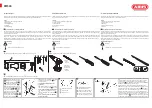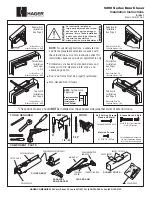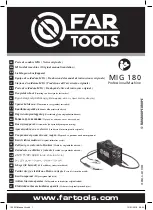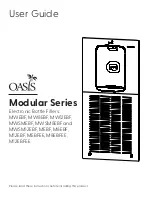
11
ESP
AÑOL
FRANÇAIS
DEUTSCH
ENGLISH
IT
ALIANO
to guide the wire through.
N.B.
When changing to a wire of
different diameter, check that the
correct roller groove is facing towards
the
outside
of
the
unit.
The wire feeder roller supplied with the
unit bears the inscription “0.8” on one
side. When an 0.8 inscription is showing
the unit is set for use with 0.8 mm filler
wire or 0.9 mm flux-core wire. When
“1” appears on the display panel, the
welder has been programmed for use
with 1mm diameter solid wire.
Unscrew the two knurled knobs to
access the lower wirefeeder rollers (26).
N.B.
When using aluminium wire, use
the rollers with the “U”-shaped slots
instead of the ones with “V”-shaped
slots (factory configuration).
WARNING:
Before proceeding further
check the torch cable (Fig 4) is straight
and that the tip of the welding is
smooth. Heed this cautionary note to
avoid damage to the wire-feeder.
7.
Connect the mains power cable,
switch the unit on (Fig 2 – 15) and press
the wire-feed button (Fig1 – 10). The
welding wire will be fed into the torch
cable. When it exits the tip of the torch,
release the button. Switch the unit off
and install the wire-feeder guide
(Fig.4B) and the gas nozzle (Fig. 4A) on
to the torch.
WARNING:
When pressing the wire
feeder button (fig 1- 10) keep the torch
well
away
from
your
eyes.
The wire can cause serious injury!
WARNING:
The wire-feed roller can
trap fingers when rotating. Check the
state of the wire-feed rollers regularly
and replace them when worn; non-
replacement can jeopardise the smooth
wire feeding process.
7. GAS CYLINDER AND GAS
PRESSURE
REGULATOR
CONNECTIONS
Only for MIG welding: Skip this charter
entirely if the welder is to be used for
MMA welding.
Carefully follow the procedure shown
in Fig. 6:
1.
Connect the pressure regulator (2) to
the gas cylinder (3). Tighten the bolt (6)
between the regulator (2) and the
cylinder (3). Do not overtighten to avoid
damaging the cylinder valve (1).
2.
Connect the gas hose of the torch (4)
to the pressare regulator (2) and clamp
securely using a clasp (5). (Alternatively
use cylinder and hose fast connectors).
3.
Connect the other end of the gas
hose (6) to the socket on the rear panel
of the welder unit (Fig.2 – 23), securing
it with a clasp.
4.
Connect the gas hose from the torch
to the appropriate socket (7) on the
front panel of the unit (fig 1 - 33),
tightening clockwise. Do not over-
tighten.
5.
Open the gas cylinder valve (1).
Press the torch button and check that
gas is flowing through correctly.
WARNING:
Cylinders contain high
pressure gas. Handle them with care.
Inappropriate treatment can cause
4
3
2
1
6
2
5
1
3
5
Fig.6
Summary of Contents for QUEEN 210
Page 1: ...Instructionsmanual QUEEN 210 ...
Page 2: ... MB ...
Page 3: ... MB QUEEN 210 ...
Page 6: ......
Page 8: ...2 0 WARNING SYMBOLS WARNING SYMBOLS ...
Page 23: ...17 ...
Page 24: ...Cod 910 100 310GB REV01 ...








































